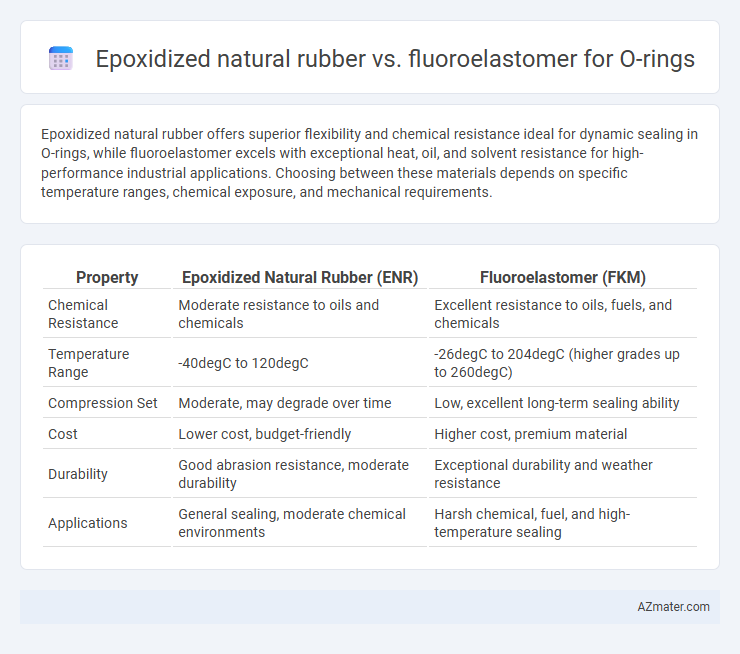Epoxidized natural rubber offers superior flexibility and chemical resistance ideal for dynamic sealing in O-rings, while fluoroelastomer excels with exceptional heat, oil, and solvent resistance for high-performance industrial applications. Choosing between these materials depends on specific temperature ranges, chemical exposure, and mechanical requirements.
Table of Comparison
| Property | Epoxidized Natural Rubber (ENR) | Fluoroelastomer (FKM) |
|---|---|---|
| Chemical Resistance | Moderate resistance to oils and chemicals | Excellent resistance to oils, fuels, and chemicals |
| Temperature Range | -40degC to 120degC | -26degC to 204degC (higher grades up to 260degC) |
| Compression Set | Moderate, may degrade over time | Low, excellent long-term sealing ability |
| Cost | Lower cost, budget-friendly | Higher cost, premium material |
| Durability | Good abrasion resistance, moderate durability | Exceptional durability and weather resistance |
| Applications | General sealing, moderate chemical environments | Harsh chemical, fuel, and high-temperature sealing |
Introduction to O-Ring Material Selection
O-ring material selection critically impacts sealing performance, with epoxidized natural rubber (ENR) and fluoroelastomer offering distinct advantages based on chemical resistance and temperature range. ENR provides excellent flexibility and oxygen resistance, suited for applications requiring high elasticity and moderate chemical exposure. Fluoroelastomer excels in aggressive chemical environments and high-temperature stability, making it ideal for automotive, aerospace, and industrial sealing solutions demanding durability and low permeability.
Overview of Epoxidized Natural Rubber (ENR)
Epoxidized Natural Rubber (ENR) is a modified form of natural rubber where epoxy groups are introduced into the polymer chain, enhancing its oil, fuel, and ozone resistance compared to conventional natural rubber. ENR exhibits excellent elasticity and good mechanical strength, making it suitable for O-ring applications requiring flexibility and resistance to environmental degradation. Its ability to maintain performance over a wide temperature range and improved chemical resistance positions ENR as a sustainable alternative to synthetic elastomers like fluoroelastomers in certain sealing applications.
Key Properties of Fluoroelastomer (FKM)
Fluoroelastomer (FKM) O-rings exhibit exceptional chemical resistance, withstanding aggressive fluids such as fuels, oils, and acids that epoxidized natural rubber cannot tolerate. Their high-temperature stability, often exceeding 200degC, makes FKMs ideal for harsh environments requiring long-term sealing performance. Additionally, FKMs provide superior compression set resistance and excellent mechanical strength, ensuring durability and reliability in dynamic sealing applications.
Chemical Resistance Comparison
Epoxidized natural rubber (ENR) offers moderate chemical resistance, particularly to fuels, oils, and ozone, making it suitable for environments with exposure to hydrocarbons and weathering, but it degrades in strong acids and bases. Fluoroelastomers (FKM), such as Viton, provide superior chemical resistance against a broad spectrum of aggressive chemicals, including high-temperature oils, fuels, acids, and solvents, making them ideal for demanding industrial and automotive O-ring applications. When selecting an O-ring, fluoroelastomers outperform ENR in resistance to harsh chemicals and high-temperature environments, while ENR remains a cost-effective option for moderate chemical exposure.
Temperature Performance Differences
Epoxidized natural rubber (ENR) offers excellent mechanical properties and moderate temperature resistance, typically performing well within a temperature range of -40degC to 120degC. Fluoroelastomers (FKM), on the other hand, provide superior thermal stability with continuous service temperatures ranging from -26degC to 204degC, making them suitable for high-temperature applications. The distinct temperature performance gap highlights fluoroelastomers as the preferred material for O-rings in extreme heat environments, while ENR is better suited for moderate temperature conditions requiring flexibility and cost efficiency.
Mechanical Strength and Flexibility
Epoxidized natural rubber (ENR) exhibits high elasticity and good mechanical strength, making it suitable for O-rings requiring flexibility under dynamic stress. Fluoroelastomers demonstrate superior mechanical strength in high-temperature and chemically aggressive environments, maintaining dimensional stability and resistance to deformation. While ENR offers enhanced flexibility due to its natural rubber base, fluoroelastomers provide greater durability and resistance, especially in applications involving oils, fuels, and harsh chemicals.
Compatibility with Fluids and Gases
Epoxidized natural rubber (ENR) offers excellent resistance to polar solvents, oils, and fuels, making it suitable for applications involving water-based fluids and certain hydrocarbons. Fluoroelastomers (FKM) provide superior chemical resistance to a broad range of aggressive fluids, including high-temperature fuels, oils, and most chemicals, alongside excellent performance against gases such as oxygen and ozone. For O-ring applications, fluoroelastomers ensure higher compatibility with diverse fluids and gases, especially in demanding industrial or automotive environments.
Cost Analysis: ENR vs Fluoroelastomer
Epoxidized natural rubber (ENR) offers a significantly lower material cost compared to fluoroelastomers, making it a cost-effective choice for O-ring applications requiring moderate chemical resistance and flexibility. Fluoroelastomers, while substantially more expensive due to their superior resistance to high temperatures, fuels, and aggressive chemicals, provide longer service life in extreme environments. Cost analysis reveals that ENR can reduce initial production expenses by up to 40%, but total lifecycle costs may favor fluoroelastomers when considering durability and maintenance in demanding industrial settings.
Application Suitability and Industry Use
Epoxidized natural rubber (ENR) offers excellent flexibility, abrasion resistance, and chemical resistance, making it suitable for automotive and general industrial O-ring applications exposed to moderate temperatures and oils. Fluoroelastomers (FKM) provide superior chemical, heat, and oil resistance, ideal for aerospace, chemical processing, and high-performance automotive industries requiring O-rings to withstand extreme temperatures up to 200degC and aggressive fluids. The choice between ENR and FKM O-rings depends heavily on the specific operating environment, with FKM preferred for harsh conditions and ENR for cost-effective solutions in less demanding settings.
Conclusion: Choosing the Right O-Ring Material
Epoxidized natural rubber (ENR) offers excellent flexibility, oil resistance, and good abrasion resistance, making it suitable for dynamic sealing applications in automotive and industrial machinery. Fluoroelastomers provide superior chemical resistance, high-temperature tolerance up to 200-250degC, and long-term durability in aggressive environments like fuel systems and chemical processing. Selecting the right O-ring material depends on the specific operating conditions, with ENR favored for moderate temperatures and flexibility, while fluoroelastomers excel in harsh chemical and high-temperature applications.

Infographic: Epoxidized natural rubber vs Fluoroelastomer for O-ring
 azmater.com
azmater.com